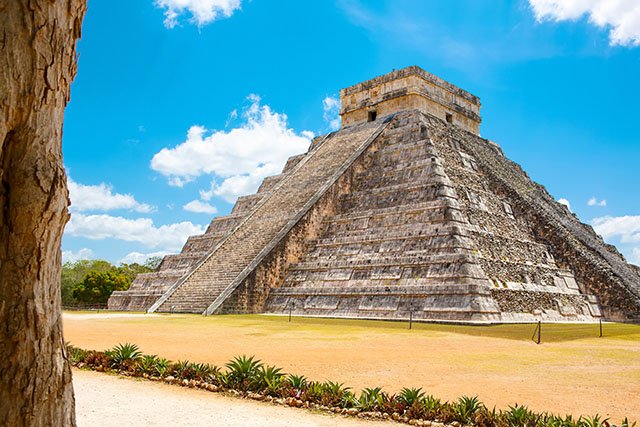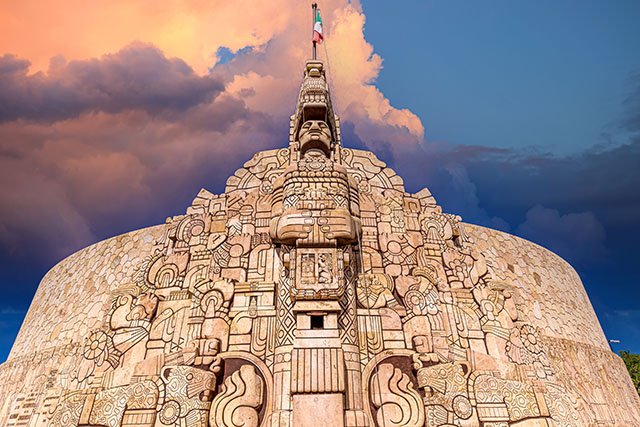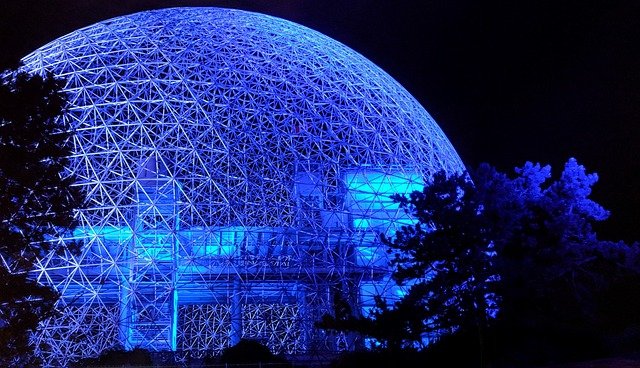Introduction to Chichen Itza
Nestled in the heart of the Yucatan Peninsula in Mexico, Chichen Itza stands as one of the most captivating archaeological sites of the ancient Maya civilization. Designated as a UNESCO World Heritage Site, this ancient city is a testament to the architectural prowess and cultural sophistication of the Maya people. Chichen Itza is not merely a relic of the past but a living monument that draws visitors from across the globe, eager to uncover its historic and architectural marvels.
Chichen Itza thrived between the 9th and 12th centuries, serving as a major center of political, economic, and religious life. The city’s layout reflects both Maya and Toltec influences, embodying a fusion of cultures that is rare and fascinating. Among its numerous attractions, the most iconic is El Castillo, also known as the Temple of Kukulcán. This towering step pyramid is ingeniously designed to create a serpent-like shadow during the equinoxes, captivating all who witness this astronomical event.
Other prominent structures include the Great Ball Court, the largest of its kind in Mesoamerica, where games of ritualistic significance were played. The Temple of the Warriors, with its impressive colonnades and intricate stone carvings, and the Sacred Cenote, a natural sinkhole that served as a site for ceremonial offerings, further illustrate the spiritual and communal life of the Maya. These attractions provide a window into the architectural ingenuity and cultural richness of Chichen Itza, making it a must-visit destination for history enthusiasts and casual tourists alike.
As we delve deeper into the historical and architectural wonders of Chichen Itza, we will explore the significance of each major attraction, unraveling the stories and mysteries that have long intrigued scholars and visitors. Whether you are planning a visit or simply seeking to understand the grandeur of this ancient city, Chichen Itza offers a journey through time, awakening a profound appreciation for the legacy of the Maya civilization.
Historical Background and Significance
Chichen Itza, founded by the Maya civilization around the 6th century AD, stands as a testament to the complex and advanced society that existed long before European contact. It emerged as a prominent city during the Post-Classic period of Mesoamerican history, flourishing between the 10th and 13th centuries. This period marked a pivotal era in which Chichen Itza became not only a cultural melting pot but also an economic powerhouse.
One of the remarkable aspects of Chichen Itza’s history is its role as a major hub for trade. The city benefited from its strategic location on the Yucatán Peninsula, facilitating the exchange of goods such as gold, textiles, and precious stones, which were highly coveted in ancient Mesoamerican markets. This economic activity fostered connections with other prominent Mesoamerican civilizations, including the Aztecs and the Toltecs, further amplifying its influence.
Significant events and rulers also shaped Chichen Itza’s historical context. The city saw the influence of powerful leaders such as K’ak’upakal, who played an instrumental role in its expansion and consolidation. Through a blend of military prowess and diplomatic alliances, the rulers of Chichen Itza built a city that was not only formidable in defense but also grand in its architectural achievements.
Despite its peak, Chichen Itza experienced a gradual decline toward the end of the Post-Classic period. Factors contributing to its downfall include internal strife, environmental changes, and shifts in trade routes. These led to its abandonment by the end of the 13th century, marking the end of an era but also cementing its status as a historical site of immense significance.
The historical importance of Chichen Itza is underscored by its designation as a UNESCO World Heritage Site. This recognition acknowledges not only its architectural and artistic achievements but also its pivotal role in the cultural and economic landscape of ancient Mesoamerica. Understanding its historical background provides invaluable insights into the rich legacy left by the Maya civilization.
The Pyramid of Kukulkan (El Castillo)
The Pyramid of Kukulkan, or El Castillo, stands as the most iconic edifice at Chichen Itza, commanding admiration for its architectural brilliance and historical significance. Renowned for its stepped structure, this pyramid epitomizes the ingenuity of ancient Mayan architecture. Rising majestically to around 98 feet, the pyramid consists of nine terraces culminating in a singular temple at the summit. Each of the pyramid’s four sides features a staircase with 91 steps, an arrangement that, when combined with the platform, totals 365 steps, symbolically mirroring the number of days in the solar year.
El Castillo’s alignment with astronomical events is one of its most captivating features. Constructed with a keen understanding of celestial dynamics, the pyramid is intricately tied to the Mayan calendar. During the equinoxes, a phenomenon occurs, captivating observers: the descent of Kukulkan. As the sun sets, a shadow in the shape of a serpent appears to slither down the northern staircase, merging with a stone serpent head at the base. This remarkable interplay of light and shadow is not merely a visual spectacle but also underscores the Mayans’ profound astronomical knowledge and their reverence for deities associated with celestial bodies.
Beyond its role in astronomical observation, the Pyramid of Kukulkan served significant ceremonial purposes. Dedicated to Kukulkan, the feathered serpent deity, the structure was a temple where rituals and offerings were conducted. It was not just a religious nexus but a grand calendar, meticulously designed to mark essential agrarian cycles and ritual events. The equinox serpent shadow phenomenon highlights this dual purpose, aligning the sacred with the scientific, and serving as a testament to the sophisticated understanding the Mayans had of the cosmos.
The Great Ball Court
The Great Ball Court at Chichen Itza stands as a testament to the grandeur and sophistication of ancient Mayan architecture. It is the largest and most well-preserved ball court in Mesoamerica, measuring an impressive 168 meters in length and 70 meters in width. The court’s walls rise eight meters high, and each wall is adorned with intricate carvings that depict scenes from the Mesoamerican ballgame, a sport imbued with profound cultural and religious significance.
Architectural features such as the sloped walls and stone rings positioned high on either side of the court highlight the game’s complexities. The objective of the Mesoamerican ballgame was to pass a rubber ball through these rings using only the hips, an endeavor that demanded incredible athleticism and skill. The carvings illustrate victorious players and, often, scenes of human sacrifice, indicating that the stakes of these games extended far beyond mere sport.
The Mesoamerican ballgame held immense importance in the social, religious, and political life of the Maya. It served as a ceremonial ritual, providing a nexus where political alliances and conflicts were played out. Rulers often commissioned these games to display power and honor deities, particularly those associated with fertility, war, and the sun. The game symbolized the cosmic struggle between light and darkness, and it was believed that the movement of the ball mirrored the celestial bodies’ journey through the skies.
Human sacrifice was a sobering component of the ballgame, reflecting the Maya’s deep religious convictions. The sacrifices were thought to be acts of devotion, offerings to the gods that ensured the continuation of cosmic order. Winners and losers alike could be offered as sacrifices, though interpretations vary regarding who faced this ultimate honor.
In sum, the Great Ball Court of Chichen Itza was far more than an arena for physical contests; it was a stage where the complex interplay of Mayan cosmology, societal norms, and political power was vividly enacted. Its preservation allows us to glimpse the intricate and profound world of the ancient Maya.
The Temple of the Warriors and the Group of a Thousand Columns
The Temple of the Warriors stands as one of the most significant structures within Chichen Itza, exemplifying the architectural prowess and artistic intricacy of the ancient Maya civilization. Featuring a stepped pyramid design, the temple is renowned for its elaborate stone carvings. These carvings often depict warriors in various postures, symbolizing the martial prowess and defensive spirit that likely characterized the society at the time. Most notably, the central figure of Chac Mool, a reclining stone statue, dominates the temple’s forefront. Chac Mool is believed to have been an intermediary between the gods and the people, playing a central role in rituals and offering ceremonies.
Adjacent to the Temple of the Warriors lies the Group of a Thousand Columns, comprising numerous carved stone pillars that once supported expansive roofed spaces. This extensive colonnade is viewed as a testament to the community’s economic and social endeavors. The layout and design suggest these columns belonged to bustling marketplaces and crowded assembly areas, where traders, artisans, and community members would converge for commerce and social interaction. The interconnectedness of these structures underscores the sophistication of urban planning in Chichen Itza, offering a glimpse into the daily life and commercial activities that were central to its inhabitants.
By exploring the Temple of the Warriors and the Group of a Thousand Columns, visitors can gain deeper insights into the dynamics of societal organization within Chichen Itza. The intricate artwork and the expansive colonnade not only highlight the architectural ingenuity of the Maya but also open a window into the cultural and economic vitality of this ancient city. For anyone seeking to comprehend the full spectrum of Mayan urban and ceremonial life, these structures provide invaluable clues and a richer understanding of Chichen Itza’s historical significance.
Sacred Cenote and the Role of Water in Mayan Culture
The Sacred Cenote at Chichen Itza is a profound testament to the spiritual and cultural significance of water in Mayan civilization. This natural sinkhole, also known as a cenote, was not just a water source but a pivotal element in religious ceremonies and daily life for the Maya people. Located to the north of the main ceremonial center, the Sacred Cenote served as a ritual site where offerings were made to the gods, reflecting the deep reverence the Mayans had for these natural formations.
Archaeological excavations of the Sacred Cenote have uncovered a wealth of artifacts, including pottery, jade, gold, and even human remains. These findings suggest that the cenote was a focal point for offerings and possibly sacrifices aimed at appeasing the gods and ensuring the abundance of rain and favorable agricultural conditions. Rituals performed at the Sacred Cenote likely included prayers, dances, and the casting of precious items—sometimes even human lives—into its depths as an act of devotion and supplication.
Cenotes like the Sacred Cenote were central to Mayan cosmology, representing portals to the underworld, or Xibalba. The Maya believed these sacred waters were inhabited by gods and spirits, making cenotes pivotal in both religious and mythological contexts. Water was viewed as a life-giving force and a conduit to the divine, intertwining the natural world with the spiritual realm.
Beyond their religious significance, cenotes were vital for the daily sustenance of the Mayan people. They provided a crucial source of fresh water in a region where surface water is scarce. The cenotes’ cool, clear waters were essential for drinking, irrigation, and various household uses. Thus, cenotes shaped the Mayan way of life, influencing settlement patterns, agriculture, and social structures.
In conclusion, the Sacred Cenote at Chichen Itza is a powerful emblem of the integral role water played in Mayan culture. Through religious rituals and daily reliance, cenotes were revered as sacred and indispensable, highlighting the intricate connection between natural resources and spiritual beliefs in this ancient civilization.
Astronomical Observations and the Mayan Calendar
Chichen Itza stands as a testament to the advanced astronomical knowledge held by the Maya civilization. One of the most striking structures illustrating this expertise is El Caracol, commonly referred to as the Observatory. This unique building bears a spiraled design reminiscent of a snail’s shell, facilitating its name, which translates to ‘snail’ in Spanish. The purpose of El Caracol extended beyond mere architectural novelty; it served as a dedicated center for celestial observation, enabling the Maya to track and interpret important astronomical events.
El Caracol’s precise construction allowed ancient astronomers to monitor the movement of celestial bodies with remarkable accuracy. Its windows are strategically aligned with significant points in the solar and lunar cycles, facilitating the study of equinoxes, solstices, and the appearance of Venus, which held particular significance in Mayan culture. By observing these celestial phenomena, the Maya developed a calendar system that was extremely sophisticated for its time, enabling them to predict seasonal changes and enhance agricultural productivity.
Beyond El Caracol, the broader architectural landscape of Chichen Itza reflects deep celestial knowledge and manifests the Mayan calendar’s complexity. The alignment and positioning of various structures, including the legendary Pyramid of Kukulkan, highlight this expertise. For instance, during the equinoxes, the play of sunlight and shadow produces a mesmerizing effect on the pyramid, creating the illusion of a serpent slithering down the stairs. This aligns with Mayan beliefs that associated Kukulkan, the feathered serpent deity, with celestial events.
These elements of architecture and their astronomical alignments are direct representations of the Mayan Long Count calendar system. This calendar extended beyond the simpler 365-day Haab calendar and the 260-day Tzolk’in, providing a broader, cyclical understanding of astronomical and terrestrial events. Through careful and continued study of celestial movements, the Maya incorporated these observations into their everyday lives, influencing their agricultural, ceremonial, and civic activities, thereby embedding astronomy deeply into their cultural fabric.
Chichen Itza Today: Preservation and Tourism
Chichen Itza stands today not only as a testament to the ingenuity of the ancient Mayan civilization but also as a vibrant tourist destination teeming with historical and cultural significance. The site continues to draw millions of visitors annually, eager to explore its architectural wonders, from the iconic Pyramid of Kukulcan to the intricate carvings of the Temple of the Warriors. Thanks to intensive preservation efforts, spearheaded by UNESCO, Chichen Itza has been maintained in a state that allows both education and enjoyment.
UNESCO’s designation of Chichen Itza as a World Heritage Site underscores its global importance and necessitates a comprehensive approach to its preservation. In partnership with the Mexican Government and various international organizations, ongoing projects ensure that the site’s structural integrity remains intact. These efforts include meticulous restoration, routine maintenance, and sophisticated archaeological research to uncover and protect remnants of Mayan history. These preservation activities require substantial funding and global cooperation, highlighting the universal value placed on Chichen Itza’s heritage.
For visitors, exploring Chichen Itza requires a balance between curiosity and responsibility. To experience the site fully, it is advisable to visit during the early morning or late afternoon when the crowds are thinner and the temperatures more manageable. Guided tours offer in-depth insights into the site’s historical context and architectural nuances, enhancing the educational aspect of the visit. When touring Chichen Itza, it is essential to practice sustainable tourism. This includes following pathways, respecting cordoned-off areas, and refraining from touching or climbing on the structures to prevent damage.
Furthermore, supporting eco-friendly tour operators and purchasing locally-made souvenirs can positively impact the surrounding community and economy. By visiting Chichen Itza with a sense of reverence and responsibility, tourists contribute to the preservation of its majesty, ensuring that this ancient Mayan city continues to inspire and educate future generations.









